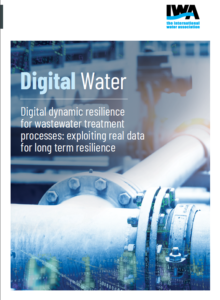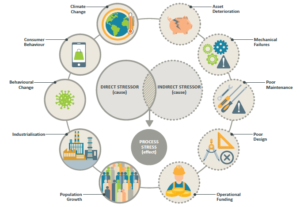With societal (e.g., COVID-19) and climatic factors coinciding with increasing regulatory pressures, the resilience of wastewater networks and infrastructure is reducing globally. Historically, water companies have relied on reserve capacity, but are now being forced to manage extreme dynamic responses as wastewater assets react to new stressors.
To avoid possibly cumbersome modelling and simulation of possible scenarios, dynamic resilience uses actual data from water resource recovery facilities (WRRF) to visualise zones of process stress and resilience as a heat map. The methods presented in this white paper separate stressors present in water company data as the ‘cause’ of an event, and the ‘effect’, whether a WRRF experiences process stress or resilience as a result.
This white paper starts by describing the historical context of resilience, before moving on to the dynamic resilience of wastewater processes and WRRF. Real-world examples of societal and process-related resilience from industrial and academic experts are provided, which discuss the challenge of generating data under the uncertainty of ageing infrastructure. A case study is then presented on dynamic resilience using actual WRRF data. The case study shows how actual water company instrument data could be used to evaluate stressors and process stresses independently. The outcomes of dynamic resilience case studies are then presented as a series of contoured heat maps.
This publication is part of the Digital Water Book which will be launched at the upcoming IWA World Water Congress & Exhibition. Stay tuned for more information!
Report authors:
Timothy Grant Holloway Senior Scientific Officer at University of Portsmouth School of Civil Engineering and Surveying
John Barry Williams Professor of Environmental Technology at University of Portsmouth School of Civil Engineering and Surveying
Djamila Ouelhadj Professor of Operational Research at the University of Portsmouth department of mathematics
Gong Yang Process capacity Manager at Southern Water Services Ltd
Ben Martin Lead Research Scientist at Thames Water
Matthew Wade Science Lead: Wastewater Research and Development, Environmental Monitoring for Health Protection, Data Analytics and Surveillance at the UK Health Security Agency
IWA Digital Water Programme
This paper is a part of a series of white papers under the IWA Digital Water Programme, which aims to generate and share knowledge on digitalisation of the water industry. The Programme acts as a catalyst for innovation, knowledge and best practice; and provides a platform to share experiences and promote leadership in transitioning to digital water solutions. By sharing experiences on the drivers and pathways to digital transformation in the water industry, the programme is consolidating lessons and guidance for water utilities to start or continue to build their journey towards digitalisation.
Learn more about the IWA Digital Water Programme.



